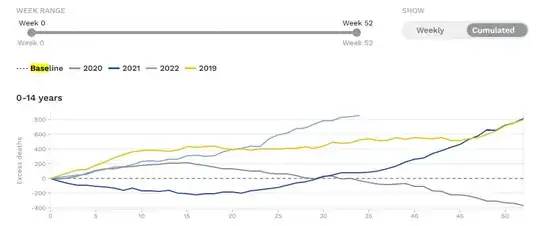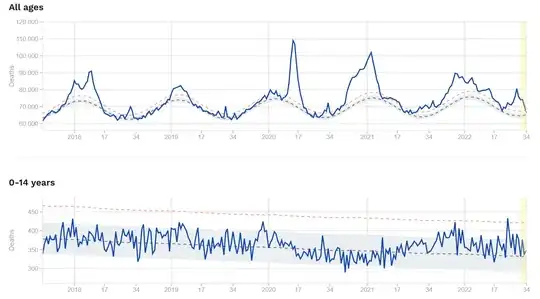"Caveat percentor"
You can DL the dataset from EuroMOMO and do the simple arithmetic yourself. (Sorry no direct link to the dataset seems possible; they use some AJAX or stuff like that.) It's not 100% clear what formula the blog claims uses, or the exact period involved, but one thing it states is "compared with the same time period in 2021".
So let's look at a few periods; for 2021, the cumulative excess ("observed count" minus "baseline", summed from first week of the year) is actually negative for the first half of the year (i.e. below long-term baseline) and only crosses zero in the 2nd half of that year, so for 2021 you get excess numbers (in the 0-14 age group) like
- First 34 weeks: 80.98
- First 30 weeks: 23.82
- First 29 weeks: -13.12
The corresponding excess numbers for 2022, all well above the baseline
- First 34 weeks: 855.67
- First 30 weeks: 787.32
- First 29 weeks: 742.06
So, using the (b-a)/a x 100 percentage increase formula one can make various claims about the excess like:
- 957% increase for the first 34 weeks
- 3,205% increase for the first 30 weeks
- -5,756% increase for the first 29 weeks ????
It shows more that when talking about percent increase for an excess-above-baseline figure (which can be even negative) one can get even more "whatever you like" results near zero (for the first/reference item) than just truncated graphs.
I can't read the full blog because it's paywalled, but if the author is somehow speculating about causes... Covid vaccines in children probably aren't one because (to quote a bit more form the "RMIT ABC Fact Check" article linked by Mad Scientist)
European countries only began vaccinating their 5-11 year-olds from December 2021, and the European drugs regulator is yet to approve COVID-19 vaccines for children under 5.
But the excess numbers for the 2nd half of 2021 are rather high well before December. E.g for weeks 27-52 of 2021 the excess I get is 903.45. Even if you drop the last 4 weeks (December), it's 746.43. This point was raised in the RMIT piece linked as
Viewed this way, the EuroMOMO data shows there were 910 excess deaths in the last half of 2021, and 611 in the first half of 2022 — meaning excess deaths among under-15s fell by 33 per cent.
(For some reason, I don't get the exact numbers claimed there; I get 903.45 vs 910 and 618.21 vs 611, but they are close enough to what the RMIT article claims to roughly check its claims/calculations. The small diff might be because the baseline has changed in the more recent dataset, or something like that. As noted on the methods page or EuroMOMO, the baseline they calculate [and which is pre-calculated by them in the downloaded data set] for the 0-14 age group is described as "linear trend, no seasonality". I'm guessing that baseline is derived from the 5-year data set they provide, which actually seems to drop a week from 2017 for every week of 2022 that is added as time passes [the DL set only goes back to week 36 of 2017 right now], although the methods description isn't too clear on the latter aspect.)
As I scrolled to the bottom of the EuroMOMO page, I see there is a cumulated graph they provide themselves, in case you doubt my high level description of what the data looked like, relative to the baseline they calculate.

I've added 2019 to the default view/selection (which only includes the pandemic years by default) to see how the 2022 might relate to one year before the pandemic.

